A friend of mine was selling his old GS500 '91. He could not afford the
insurance and had his bike abandoned in a parking for about 2 years.
I got it. It had 39000Km on the counter and a lot more of problems
that have been being solved since I got the bike in september2000.
The bike had a dead battery that came back to life after a good charge
(can't believe it!) but refused to start. I'm sure it was because of the
old fuel in the tank. So I went, got the Clymer manual, and started some
maintenance on it.
The carburetor cleaning, valve job and camshaft chain inspection I did
on October2000 was repeated in March2001 because the bike was not working
propperly. The photos shown in this web were taken during this second 'rebuild'.

|
Aspect of the bike, after the seat and side covers removal.
Somebody installed a wrong battery (breather in the opposite side).
The vapors coming out the battery rusted (nearly eated) cables connectors
and fastons of the black box. Not a good spectacle to see. |

|
Remove the tank. Only 2 screws.
Close the cock under the tank and remove hoses.
Larger tube (right in the photo) goes to L shaped intake in petcock.
Shorter tube goes to general intake in petcock. |

|
Remove air filter. 2 screws at each side of the frame, and 2 that
will link to the carburetors.
At this time, you might want to start the bike and see how both carburetor
slides work as you wind the throttle.
This will give you an idea if they are both working OK.
You might see the "slides jumping spectacle": At low rpm, when the engine
sucks air, slides lift up because of the vacuum generated. As soon as valve
closes the air flow, they will fall down again.
Soon you will run out of fuel. |

|
2 screws will hold carbs to the engine intake manifolds.
Remove gas cable and choke cable.
Remove hoses coming from the petcock:
-
upper T: goes to lower part of the bike: fuel overflow.
-
lower T: fuel intake coming from the petcock.
-
vacuum tube that will automatically enable fuel to travel from tank to
carbs through the petcock. PRI position does not require vacuum to let
fuel reach the carbs.
Remove carbs assembly. |
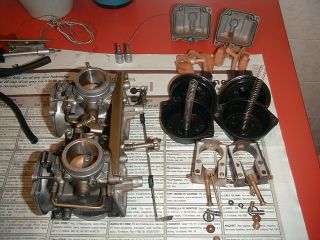
|
Disassemble everything:
-
Upper rubber diaphragm. Inspect for holes or cracks.
-
Do not miss any o-ring. Replace if missing or dried out.
-
Unscrew jets. Before removing main jet, hit with a hammer: this will move
needle jet out of its place for easy removal.
-
There's a o_ring hidden under the slider support.
-
Inspect needle valve.
-
Inspect main jet (120 or 122.5)
-
Inspect jet needle (5DH9 or 5DH8)
-
Inspect needle jet (0-3)
-
Inspect pilot jet (37.5)
Do not mix parts from one carb to another. |

|
See how dirty came out the bowls.
See the needle jet with little holes full of dirt (rust coming from
the tank)
There was a thorough clean work done here, and it only needed 6000Km
to show again this dirty aspect. Guys: keep rust from getting your tank. |
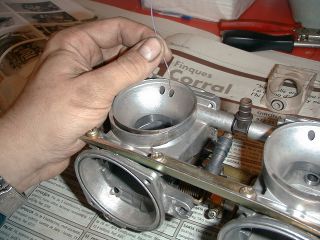
|
Clean thoroughly carbs bodies.I used diesel and a brush. Then rinsed
with soapy water. Some diesel and a thin wire will let you clean all these
little holes where dirt uses to hide.
-
The hole shown in the photo feeds air to the needle jet. (remember to clean
needle jet holes too)
-
The hole next to it, feeds air to the mixture screw circuit.
-
upper "D" shaped big hole is the vacuum circuit that will lift the slider.
-
Clean thoroughly the choke circuit (other side of the carbs)
-
Clean too these little 4 holes in the air enrichment circuit (mixture screw
circuit).
-
Clean both fuel intake holes and nedle valve seat.
|

|
Just installing the needle jet.
-
You need to install the slider support (while plastic), and check that
the o-ing at the bottom is in good condition.
-
Then slide the needle jet (see photo). It must be inserted in a position:
inspect carb body (needle jet housing) to see that there is a small notch
that will prevent the needle jet from being installed the wrong way.
|
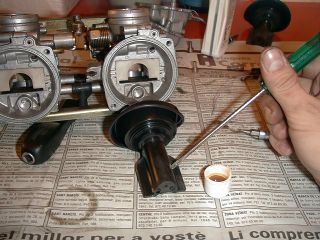
|
I use to lubricate parts with 2-strokes oil. |

|
Installing the main jet. |
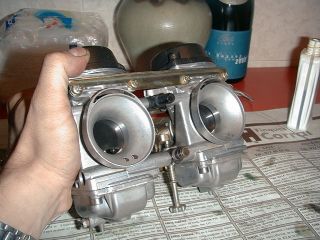
|
Carburetor assembly rebuild finished.
Mixture screw set to 2 turns out (default). Play with 2 to 4 turns out.
Jet needle in the middle position, might want to lift it by 1 notch
to get a richer mixture. (GS500 uses to be lean at high RPM) |

|
Okay returning to the bike let's check camshaft to shim clearance.
It should be between 0.03mm and 0.08mm
Remove valve cover by:
-
1: remove head cover breather (4 screws)
-
2: remove bead cover (6 screws)
-
Be careful with the head cover gasket. Replace if dried out. (10$)
|

|
You will need a thickness gauge to do the valve job.
It's not expensive but a little difficult to find one that will suit
your needs.
You need one that will neasure 0.03mm and 0.08mm
I got that in one of these cheapo tool kits (100 tools for 25$)
|

|
Remove right "suzuki" cover and locate the R and R-T marks.
Align pick-up with R-T mark with a 19mm wrench. |
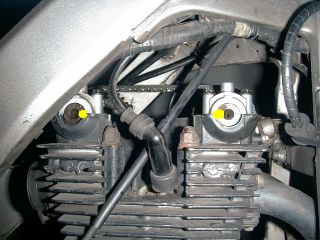
|
The marks on the camshaft should be facing one to another.
If they are one opposite to another, turn the crankcase 1 complete
turn and realign pickup to R-T |
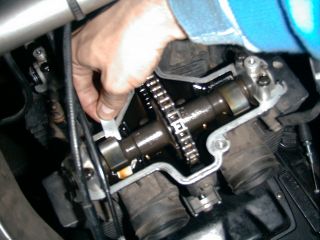
|
With the engine at that point (see 2 last photos) measure the
gap under the camshaft lobes in all but exhaust left valve.
Slide a thickness gauge between the camshaft and the shim.
There should be a gap between 0.03mm and 0.08. If it is out of specs,
replace the shim with a 0.05mm thinner or thicker.
Rotate the engine 1 complete turn to measure exhaust-left valve.
To replace shims you can use a special tool. I don't have one: I removed
camshaft supports and replaced it easily. |
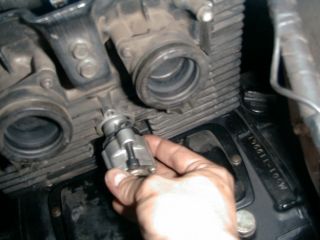
|
Now it's a good time to check if camshaft chain tensioner is OK.
Remove 2 allen bolts and remove tensioner.
You will surely hear a "klatch" when you remove it: it's the tensioner
that relaxed its spring. |

|
Use a screwdriver to check that camshaft chain tensioner is working
OK. |

|
Reinstall chain tensioner:
-
Use the screwdriver to keep the spring from pushing the tensioner arm.
-
Install the tensioner.
-
Remove the screwdriver so that the spring relaxes and pushes camshaft chain
CAMSHAFT CHAIN INSPECTION:
-
Check for different tensions all along the chain by rotating the engine.
-
Measure 20 links (21 pins). They should measure no more than 157.8mm (6.21inches).
|

|
-
Reinstall head valve cover and replace gasket if dried out.
-
Reinstall breather cover.
-
Tighten bolts securing carbs to intake manifold.
-
Reinstall throttle cable. Move steering to ensure that there is a little
play in all positions.
-
Reinstall choke cable.
|

|
Now it's a good opportunity to install a fuel filter.
Install a small piece of hose between the lower "T" of the carbs, attach
the filter to that, and build another piece of hose to connect to petcock
output.
|

|
Install air filter box. A new air filter element is about 20$. Replace
it if it's dirty or too old.
Do not miss to:
-
connect petcock vacuum hose to left carb.
-
connect battery breather hose.
-
Ensure that all cables are proppery routed through the frame.
-
Ensure that breather hoses are routed to floor (canister in California),
except valve cover breather that goes to air box.
If I had a vacuum meter, I could check if carbs are both working fine. |

|
Reassemble everything, pull choke and crank the engine.
It should start and you will need to reset idle screw (middle of the
carbs) to set it up to 1200RPM. |
























 MENU
MENU